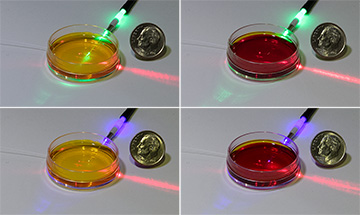![]()
Researchers in the United States and Australia have developed a noninvasive, instant method for measuring a liquid’s pH, using laser light, an optical-fiber probe, and some basic chemistry. [Image: Jennifer Lauren Lee/NIST]
Skip the litmus paper—a new type of pH sensor, based on light and under development by an international research team, could both give users instant visual readout and record a signal over time without disturbing biological systems being monitored (Sens. Actuators B, doi: 10.1016/j.snb.2019.127076). The researchers believe that their proof-of-concept device could also form the design basis for other types of sensors.
Such a versatile pH sensor, according to coauthor Zeeshan Ahmed, a chemist at the U.S. National Institute of Standards and Technology (NIST), could have applications in tissue engineering or for monitoring the progression of diseases like cancer. Monitoring critical properties of tissue like pH, he says, could greatly benefit studies aimed at the ability to grow teeth, heart tissue, bone tissue, and more.
“Our primary motivation is to develop a range of non-destructive measurement tools that would allow tissue engineers to track the health of their cell culture without the need to ever disturb it, either by taking the cells or the instrumentation out of the incubator,” Ahmed says. “We started with pH, because it was at the top of our collaborators wish list. Next up might be a calcium ion detector for studying bone formation.”
Cross-disciplinary technology
The proof-of-concept device marries photonics and chemical technologies. The research team, which also includes investigators from American University, USA, and Queensland University of Technology, Australia, uses a fiber-optic-based platform that measures the heat released by pH-sensitive, color-changing chromophores upon absorption of light.
The chromophores are incorporated in a cross-linked hydrogel coating a small optical fiber etched with a Bragg grating. Changes in temperature or pressure alter the wavelength of light that can pass through the grating, turning the fiber into a photonic thermometer. The pH can be recorded over time via photothermal spectroscopy or read visually at a given moment by color changes in the matrixed chromophores.
“That’s a great advantage of this technology,” Ahmed says. “The dye gives you an instant feedback, while using the photothermal spectroscopy you are able to record a signal that gives you quantitative information.”
Color enables continuous measurement
In one version of the experiment, a petri dish is filled with a solution of phenol red, which changes color depending on acidity (deep yellow for low pH; reddish for higher pH levels). Depending on its color, the liquid absorbs more or less of the green laser light versus the blue laser light. Measuring the temperature changes in the liquid as a result of light absorption (using an optical fiber probe) allows the exact color of the liquid, and thus its pH, to be assessed. [Image: Jennifer Lauren Lee/NIST] [Enlarge image]
Color change in litmus or other materials is a well-known means of determining pH or other environmental conditions. For their photonic system, the researchers correlated temperature with pH-induced color changes by placing the sensor in a glass tube holding a solution of either litmus or red cabbage powder, which also changes color according to pH, a familiar demonstration in high-school chemistry labs.
The researchers then introduced red or green light via another optical fiber. By manually changing the pH of the solution, they could correlate the color changes of the solution with temperature changes read by the sensor for both types of light.
Wide operating range
Ahmed says the experiment works over a wide pH range, 4 to 10. Ongoing work shows the photonic pH measurements are accurate to plus or minus 0.13 pH units and are stable for at least three weeks, much longer than conventional measurements. What’s more, the researchers say, the photonics sensor’s small size and resistance to fouling or clogging are significant advantages over commercial pH sensors that include bulky electrodes and cabling.
“So far, the longest-running experiment has been a month long during which we didn’t see any statistically significant drift in our sensor,” Ahmed says. “Currently, the degradation of the sensor performance is tied to degradation of the laser pointers we’re using. Replacing those with better-quality LED light sources should mitigate that issue.”
“What these sensors could give people is real-time information about tissue growth and disease progression,” says co-author Matthew Hartings, an American University chemist and guest researcher at NIST. He notes that conventional sensors—based on the Beckman pH-meter that measures hydrogen ion concentrations—offer only a series of snapshots, whereas photonic sensors could give continuous information, the equivalent of a GPS navigation app.
The hydrogel advantage
Ahmed says the team discovered that the efficiency with which chromophore turns absorbed light into heat appears to increase when using hydrogels. He says that’s because there is better co-localization of the incoming light and the fiber thermometer and small working volumes for the experiment.
In the proof-of-concept experiment, “the laser light gets absorbed as soon as it hits the solution, heating the layer of water closest to the glass tube’s surface the most. In that setup the fiber is typically a millimeter or two away from the front surface of the glass tube, so it sees less heating around itself. By putting everything in a hydrogel we have put the sensor closer to the region where the most amount of light absorption occurs,” Ahmed says.
Asked what’s needed to move the photonics pH sensor from proof of concept, Ahmed has one word: “Packaging. We are currently working on incorporating the dye and two fibers—the fiber thermometer and the fiber that brings in the excitation light—in a hydrogel matrix. That will not only improve the sensor performance but also make it easy to handle the sensor.”

